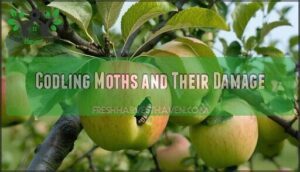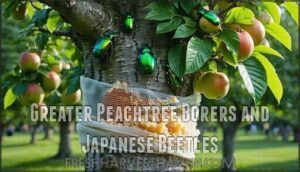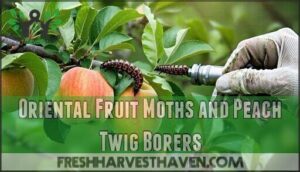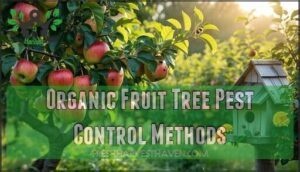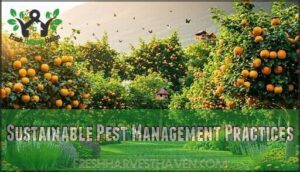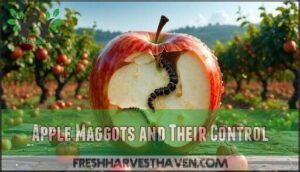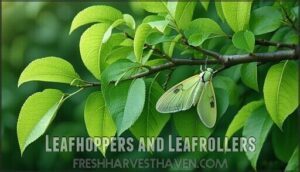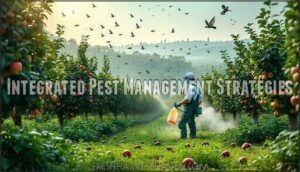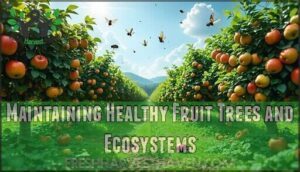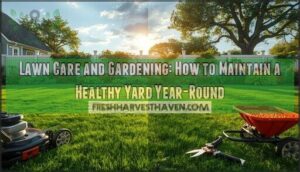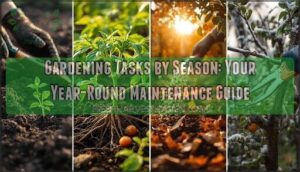This site is supported by our readers. We may earn a commission, at no cost to you, if you purchase through links.
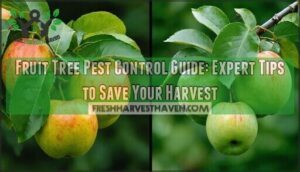
You’ll face aphids, codling moths, and Japanese beetles that can devastate your harvest if left unchecked.
Start with prevention: choose disease-resistant varieties, guarantee proper spacing for air circulation, and maintain healthy soil.
Organic methods like beneficial insects, neem oil, and companion planting work well for light infestations.
For severe problems, targeted pesticides applied at the right time prove more effective.
The secret lies in integrated pest management – combining multiple strategies rather than relying on one solution.
Timing your interventions with pest life cycles makes all the difference between success and failure.
Table Of Contents
- Key Takeaways
- Protecting Fruit Trees From Pests
- Identifying Common Fruit Tree Pests
- Preventive Measures for Fruit Tree Pest Control
- Organic Fruit Tree Pest Control Methods
- Chemical Pest Control Options for Fruit Trees
- Sustainable Pest Management Practices
- Managing Specific Fruit Tree Pests
- Fruit Tree Pest Control Schedules and Frequencies
- Integrated Pest Management Strategies
- Maintaining Healthy Fruit Trees and Ecosystems
- Frequently Asked Questions (FAQs)
- How to get rid of pests on fruit trees?
- What’s the best thing to spray fruit trees with?
- How often should I spray neem oil on fruit trees?
- How many times a year should you spray fruit trees?
- How do pests affect fruit shelf life?
- What types of birds deter fruit tree pests?
- Are certain soil types more pest-prone?
- How to handle pests during tree blossoming?
- How to handle resistant pest populations?
- When to rotate different pesticide types?
- Conclusion
Key Takeaways
- Identify pests early through weekly inspections – You’ll spot damage signs like curled leaves, entry holes, and webbing before infestations spiral out of control and devastate your harvest.
- Combine multiple control methods for best results – You’ll achieve 30% higher yields by mixing organic treatments like neem oil and beneficial insects with targeted chemical sprays when needed.
- Time your treatments with pest life cycles – You’ll maximize effectiveness by applying dormant oils before bud break, targeting codling moths at petal fall, and adjusting spray schedules based on weather conditions.
- Build natural defenses through proper tree care – You’ll create pest-resistant trees by maintaining healthy soil, ensuring good drainage and air circulation, and choosing disease-resistant varieties for your climate.
Protecting Fruit Trees From Pests
Your fruit trees face constant threats from aphids, codling moths, and dozens of other pests that can destroy your harvest before you even notice they’re there.
Silent invaders are plotting against your harvest right now—but you can outsmart them with the right knowledge.
Understanding these common invaders and their telltale signs—like curled leaves, tiny entry holes in fruit, or suspicious webbing—gives you the power to protect your trees and secure a healthy, abundant crop, ensuring you can take action against these common invaders.
Common Pests Affecting Fruit Trees
Several destructive fruit tree pests threaten your harvest each season. Identifying these common fruit pests early prevents devastating crop loss and maintains tree health.
Here are five major threats you’ll encounter:
- Aphids – These tiny sap-suckers cluster on new growth, causing leaf curl and stunted development
- Codling moths – Their larvae bore into apples and pears, creating unsellable fruit
- Spider mites – They weave telltale webbing while draining plant cells
- Scale insects – These armored pests attach to branches, weakening overall tree vigor
- Apple maggots – Adult flies lay eggs inside developing fruit, ruining your harvest
Signs of Infestation and Damage
Knowing which pests threaten your trees is only half the battle—spotting their handiwork early makes all the difference.
Your fruit trees communicate distress through visual cues that tell their story. Leaf discoloration appears as yellowing patches or bronze stippling across foliage. Chewed leaves display ragged holes or skeletal remains where beetles have feasted. Webbing signs stretch between branches like tiny spider highways, while frass presence leaves dark specks beneath infected areas.
Fruit damage ranges from surface scarring to premature dropping, often accompanied by sticky honeydew residue.
Watch for these specific indicators:
- Curled or distorted new growth from aphid feeding
- Small entry holes with sawdust-like droppings around fruit
- Silver trails on leaves from leafminer tunneling
- Brown spots or lesions spreading across fruit surfaces
- Wilting branches despite adequate soil moisture
Regular inspection prevents minor pest infestations from becoming major headaches.
Impact on Fruit Tree Health and Yield
Fruit tree pests deliver a devastating one-two punch to your orchard’s productivity and health.
Your orchard becomes a battleground where uninvited pests wage war against your precious harvest.
When these invaders establish themselves, yield reduction becomes immediate and severe—expect 40-70% fewer fruits as pests directly damage developing crops.
This pest impact triggers a downward spiral: weakened trees lose their natural tree vigor, making them sitting ducks for diseases that healthy trees would normally resist.
Tree weakening doesn’t stop at this season’s harvest.
Growth stunting occurs as pests drain essential nutrients, while disease susceptibility increases dramatically in compromised trees.
Your fruit quality suffers too—blemished, undersized, or malformed fruits become the norm rather than exception.
Fruit tree pests create cascading problems that compound yearly, making immediate intervention vital for protecting both current harvests and future productivity.
Identifying Common Fruit Tree Pests
You can’t fight what you can’t see, so learning to identify common fruit tree pests is your first line of defense against a ruined harvest.
Recognizing the telltale signs of aphids clustering on new growth, codling moth entry holes in your apples, or the metallic glint of Japanese beetles will help you take swift action before these unwanted visitors destroy your fruit.
This approach allows you to take swift action before the pests cause significant damage, protecting your harvest and ensuring the health of your fruit trees.
Aphids and Their Control Methods
Dealing with aphids requires understanding their rapid reproduction through the aphid lifecycle, where populations can explode within days on your fruit trees.
These tiny green or black insects cluster on new growth, extracting sap and causing leaves to curl dramatically. You’ll notice their sticky honeydew coating leaves, which attracts ants and promotes sooty mold growth.
Effective aphid control combines multiple strategies:
- Natural predators like ladybugs consume 40-50 aphids daily, providing excellent biological control
- Water sprays forcefully dislodge colonies from tender shoots and leaves
- Insecticidal soap ruptures aphid cell membranes on contact for immediate results
- Systemic insecticides offer longer-lasting protection but require careful application timing
- Resistant varieties naturally repel aphids through genetic traits or leaf characteristics
Monitor weekly during spring growth periods when aphid populations peak, and act quickly when you spot the first clusters forming.
Codling Moths and Their Damage
Among all fruit tree pests, codling moths stand out as the ultimate harvest thieves.
These sneaky insects follow a predictable codling lifecycle, with adults laying eggs on developing fruit. Once hatched, larvae bore deep tunnels, creating extensive fruit damage that renders apples and pears inedible.
You’ll spot codling moth damage through small entry holes and brown, sawdust-like frass around affected fruit.
Combat them using pheromone traps for monitoring and mating disruption, while organic solutions like Bacillus thuringiensis provide effective larval control during their vulnerable stages.
Greater Peachtree Borers and Japanese Beetles
Two destructive fruit tree pests demand your immediate attention: greater peachtree borers and Japanese beetles. These insects attack different tree parts but cause equally devastating damage through their distinct approaches.
Borer Life Cycle creates the most destruction when larvae tunnel into trunk bases, leaving telltale gummy ooze mixed with sawdust-like frass. Beetle Damage Signs appear as skeletonized leaves from metallic green adults feeding in groups during warm days.
The borer larvae can severely damage trees by feeding on the tree’s cambium layer.
Pest identification becomes essential for effective pest control:
- Preventative Barriers like window screen wrapping around trunk bases
- Targeted Insecticides applied during peak emergence periods
- Natural Predators encouraged through beneficial insect habitat creation
Oriental Fruit Moths and Peach Twig Borers
Beyond the metallic menace of Japanese beetles, oriental fruit moths and peach twig borers present their own challenges.
These sneaky fruit tree pests target new growth with precision. You’ll spot damage symptoms like wilted shoot tips and dying branches.
Understanding their life cycle helps with control timing—both pests overwinter as larvae. Pheromone traps work brilliantly for monitoring oriental fruit moths, while natural enemies like parasitic wasps provide biological control.
Effective fruit tree pest control requires proper spray timing when larvae are most vulnerable.
Chocolate brown larvae
Proper spray timing
Preventive Measures for Fruit Tree Pest Control
You can stop most fruit tree pests before they become a problem by creating the right growing conditions from the start.
Smart planning with proper spacing, drainage, and variety selection builds your tree’s natural defenses, making your job easier throughout the growing season, by utilizing proper spacing.
Importance of Sunny Locations and Good Drainage
Your fruit tree’s location determines whether you’ll harvest bushels or battle bugs. Sunlight exposure of 6-8 hours daily supercharges tree vigor, creating natural pest resistance that chemicals can’t match. Think of sunshine as your tree’s daily vitamin—without it, weakened trees become pest magnets.
Soil drainage matters just as much. Test it by digging a hole and filling it with water. If water sits longer than 6 hours, you’ve got drainage problems that compromise root health and invite trouble.
Here’s your sunny location checklist:
- Choose spots with morning sun to dry overnight moisture
- Avoid low-lying areas where water pools after rain
- Confirm good drainage through raised beds or soil amendments
This foundation approach strengthens fruit tree health while supporting long-term disease prevention.
Proper Tree Spacing and Air Circulation
Spacing benefits your fruit trees by creating a natural pest defense system. When you plant standard trees 15-20 feet apart, you’re establishing ideal density that prevents overcrowding issues.
This proper spacing allows air circulation to move freely through your orchard, quickly drying wet leaves after rain or irrigation.
Regular pruning enhances this airflow by opening dense canopies, letting sunlight exposure penetrate inner branches where pests often hide. The combination works like a one-two punch against insects and fungal problems.
Improved airflow means fewer humid microclimates where aphids, spider mites, and scale insects thrive. Disease prevention becomes easier when air moves freely, reducing moisture buildup that encourages pest reproduction and fungal growth throughout your orchard.
Disease-Resistant Fruit Tree Varieties
Disease-resistant varieties act like your orchard’s immune system, fighting fruit tree pests before they establish.
Your variety selection should prioritize regional adaptations—’Baldwin’ pears resist fire blight in humid climates, while ‘Arapaho’ blackberries tackle rust diseases.
Rootstock influence matters too, as resistant rootstocks strengthen tree defenses.
Modern breeding creates cross-pollination benefits without sacrificing taste.
These varieties reduce pesticide needs by 30-70%, making pest prevention both effective and sustainable for your harvest.
Gardeners can also consider planting apple trees for their versatility and ease of growth.
Insect Netting and Tree Guards
Physical barriers offer foolproof pest prevention when you can’t rely on genetics alone.
Insect netting creates an impenetrable fortress against codling moths and apple maggots through proper netting installation with tight mesh and strategic support poles. Tree guards provide trunk protection while maintaining natural growth patterns.
These cost-effective solutions deliver immediate pest exclusion without chemicals. For effective fruit tree protection, consider various netting products.
- Sleep soundly knowing your harvest is protected from destructive pests
- Feel confident your investment in fruit trees won’t be wasted
- Experience pride in your chemical-free pest control success
- Enjoy peace of mind with reliable, long-term pest prevention
- Celebrate victory over persistent fruit tree pests naturally
Organic Fruit Tree Pest Control Methods
When you’re ready to tackle fruit tree pests without harsh chemicals, organic methods offer effective solutions that protect both your harvest and the environment.
These natural approaches work by using beneficial insects, homemade sprays, plant-based oils, and strategic companion planting to control pests while maintaining a healthy ecosystem around your trees.
Introducing Natural Predators and Beneficial Insects
Working with beneficial insects transforms your orchard into a self-defending ecosystem.
Attracting ladybugs brings champions that devour up to 50 aphids daily, while lacewing benefits include consuming over 200 spider mites weekly.
Parasitic wasps target codling moth larvae with 70-80% success rates.
Praying mantises eliminate 15-20 pests daily across multiple species.
Nematode control reduces root pests by 60-90% when applied properly.
These natural predators work around the clock, creating sustainable protection that strengthens with time rather than weakening like chemical alternatives.
Homemade Solutions for Pest Control
When battling fruit tree pests, homemade solutions offer powerful organic pest control without breaking the bank.
These natural pesticides protect your harvest effectively:
- Create Soap Sprays by mixing 2-3 tablespoons of pure dish soap with one gallon of water to suffocate soft-bodied insects
- Blend Oil Solutions using vegetable oil, soap, and water for persistent pest coverage
- Develop Herbal Remedies with garlic, chili powder, or vinegar to repel unwanted visitors
- Apply Water Blasts from your hose to dislodge stubborn pests naturally
Neem Oil and Insecticidal Soap
Two powerful organic pest control solutions work exceptionally well for fruit tree pests.
Neem oil products target aphids, mites, and codling moths by disrupting their life cycles—mix 2 tablespoons per gallon of water for effective pest control. For readily available options, consider neem oil applications for your trees.
Insecticidal soap suffocates soft-bodied insects on contact; combine 2½ tablespoons liquid soap per gallon. Apply both every 7-10 days during infestations.
These organic options won’t harm beneficial insects and offer excellent organic compatibility for sustainable orchards.
Companion Planting and Pest-Repelling Herbs
Beyond neem oil applications, companion planting creates your orchard’s natural defense network.
Strategic pest-repelling herbs transform your garden into a fortress against fruit tree pests while attracting pollinators and enhancing biodiversity.
Plant these aromatic pest control champions around your trees:
- Chives and garlic – repel aphids and Japanese beetles with sulfur compounds
- Lavender – deters codling moths while attracting beneficial bees
- Dill – draws parasitic wasps that eliminate caterpillars
- Thyme – confuses pest insects while improving soil health through natural antimicrobials
Chemical Pest Control Options for Fruit Trees
When organic methods can’t handle persistent pest problems, you’ll need chemical pesticides to protect your fruit trees from serious damage.
These products offer targeted control against specific pests like codling moths and aphids, but they require careful selection and proper safety measures to guarantee effective treatment without harming beneficial insects or your family.
Types of Pesticides and Their Uses
Three main categories define pesticide selection for fruit trees.
Organic pesticides like neem oil and insecticidal soap provide gentler control, breaking down quickly while targeting soft-bodied pests effectively.
Synthetic pesticides including malathion and myclobutanil deliver stronger, longer-lasting protection against severe infestations but require careful handling.
Contact pesticides coat plant surfaces temporarily, while systemic options absorb into tree tissues for extended coverage.
Insecticides tackle bugs like codling moths and aphids, fungicides combat diseases, and specialized formulations target specific pests.
See various organic pesticide products for different applications.
Choose based on infestation severity and your preferred growing approach.
Precautions and Safety Measures for Pesticide Use
Follow these essential precautions when handling types of pesticides to protect yourself and your environment. Pesticide safety isn’t optional—it’s your shield against chemical exposure.
- Protective gear protects lives: Wear gloves, goggles, long sleeves, and respirator masks
- Application timing matters: Spray during calm mornings or evenings to prevent drift
- Safe storage saves families: Keep chemicals in original containers, locked away from food
- Label instructions are lifelines: Read completely before mixing or applying
Environmental impact depends on your careful handling.
Organic Pesticides and Their Benefits
Choosing organic pesticides gives you effective pest control without compromising your family’s health or the environment.
Neem Oil disrupts over 200 insect species’ hormone systems, while Soap Sprays dissolve soft pest exoskeletons.
Bt Bacteria targets caterpillars specifically, and Kaolin Clay creates protective barriers on fruit surfaces.
Pyrethrin Use from chrysanthemums provides quick knockdown effects.
These organic methods break down faster than synthetics, reducing soil contamination while maintaining beneficial insect populations that naturally control pests.
Neem Oil
Tackles pests hiding under leaves
Homemade Sprays
Synthetic Pesticides and Their Risks
Synthetic pesticides pack a punch but come with serious baggage.
Chemical controls can trigger pesticide resistance as bugs adapt to survive your arsenal. These pesticides don’t discriminate—they’ll wipe out beneficial insects alongside the bad guys.
Human health risks increase with improper pesticide application, while environmental impact extends to groundwater and soil life.
Regulation oversight exists, but you’re the first line of defense. Always wear protective gear and follow labels religiously.
Application safety isn’t optional—it’s your shield against chemical pesticides’ darker side.
Sustainable Pest Management Practices
You can build a thriving orchard ecosystem that naturally controls pests by working with nature instead of against it.
Smart sustainable practices like companion planting, creating habitats for beneficial insects, and avoiding broad-spectrum pesticides protect your fruit harvest while maintaining ecological balance for years to come, using nature.
Companion Planting and Beneficial Insect Encouragement
Beyond chemical sprays, companion planting creates a living shield around your fruit trees.
Smart gardeners know that attracting predators and repelling pests through habitat diversity beats constant spraying.
Here’s your natural pest control blueprint:
- Plant pest-repelling herbs like marigolds and lavender near tree bases
- Establish pollinator gardens with native wildflowers to support beneficial insects
- Create insect hotels using hollow stems and wood blocks
- Maintain natural predators with shallow water sources and shelter spots
Reduced sprays mean healthier harvests.
Diverse Planting and Ecosystem Health
A thriving garden ecosystem starts with diverse planting that goes beyond companion planting.
You’ll create pollinator habitats by mixing flowering plants, pest-repelling herbs, and ground covers that boost soil biodiversity.
This integrated systems approach attracts natural enemies like beneficial insects and natural predators who’ll handle pest control for you.
The biodiversity benefits mean your fruit trees stay healthier with nature doing the heavy lifting.
Consider planting umbelliferous flowers to attract beneficial insects.
Habitat Creation for Beneficial Insects
Building a thriving ecosystem starts with Attracting Ladybugs and other beneficial insects to your orchard. Install Lacewing Shelters using bamboo tubes and create Bird Houses positioned three to five feet high.
Native Plants provide year-round nectar sources while Parasitic Wasps target codling moths naturally. Strategic companion planting with pest-repelling herbs builds natural resilience against destructive pests.
- Southeast-facing insect hotels maximize morning sun exposure for ideal beneficial insect activity
- Continuous blooming sequences from spring through fall sustain natural predators throughout growing seasons
- Undisturbed leaf litter and brush piles offer essential overwintering protection for predatory insects
Avoiding Broad-Spectrum Pesticides
Once you’ve created habitat for beneficial insects, protecting them becomes your next priority.
Broad-spectrum pesticides act like carpet bombs in your orchard, destroying helpful predators alongside pests.
This Beneficial Insect Harm disrupts natural balance and accelerates Resistance Development.
Smart growers choose Targeted Pest Control through integrated pest management.
Natural pest control methods and organic pesticides offer Alternative Methods Cost effectiveness while preventing Environmental Consequences.
Biological controls and sustainable pest management preserve your garden’s ecosystem.
| Pesticide Type | Beneficial Impact | Target Specificity |
|---|---|---|
| Broad-spectrum | High mortality | Kills everything |
| Selective sprays | Low impact | Targets specific pests |
| Neem oil | Minimal harm | Disrupts pest cycles |
| Bt bacteria | Safe for beneficials | Caterpillar-specific |
| Insecticidal soap | Gentle on predators | Soft-bodied pests |
Managing Specific Fruit Tree Pests
Different fruit tree pests require specific control strategies since each species has unique life cycles, feeding habits, and vulnerabilities that affect your targeted approach.
You’ll need to identify the exact pest causing damage before selecting the most effective treatment method, whether it’s timing sprays for apple maggots or using pheromone traps for oriental fruit moths.
Apple Maggots and Their Control
Apple maggot damage turns your prized apples into brown-streaked disasters. These sneaky fruit tree pests tunnel through flesh, making fruit inedible and ruining your harvest.
Understanding the maggot life cycle helps you time your integrated pest management strategy perfectly.
Combat these destructive pests with smart tactics:
- Deploy sticky traps for early pest identification and monitoring adult flies
- Clean fallen fruit immediately to break the pest cycle and reduce populations
- Apply targeted sprays when trapping methods indicate threshold levels
- Choose resistant varieties for long-term varietal resistance and post-harvest control success
Leafhoppers and Leafrollers
Unlike apple maggots that attack fruit directly, leafhoppers and leafrollers assault your tree’s energy-producing leaves.
Leafhopper damage appears as white stippling on foliage, while leafroller identification involves spotting rolled or folded leaves with green larvae inside.
Natural enemies like lacewings effectively control both pests when spray timing aligns with early spring emergence.
Monitor methods include checking leaf undersides weekly for leafhoppers and inspecting rolled leaves for leafroller activity.
The control methods for these pests include using Neem oil and insecticidal soap for leafhoppers, and relying on beneficial insects like lacewings for leafrollers.
It is crucial to apply these control methods at the right timing, such as early morning for leafhoppers and when leaves unfurl in spring for leafrollers.
Western Cherry Fruit Fly and Oriental Fruit Moth
While dealing with smaller pests like leafhoppers seems manageable, western cherry fruit fly and oriental fruit moths represent your orchard’s biggest threats. These destructive fruit tree pests require targeted pest control strategies focused on lifecycle targeting and regional variations.
Here’s your action plan for effective insect control:
- Deploy yellow sticky traps for fly trapping when fruit develops salmon-blush coloration
- Apply pheromone confusion techniques using mating disruption dispensers before April moth flights
- Time chemical treatments within 2 hours of female emergence to prevent egg-laying
- Monitor 500-600 degree-days after biofix for ideal moth disruption timing
- Adjust strategies based on local climate patterns and pest population genetics to ensure effective insect control and consider the impact of regional variations on your approach, as well as the importance of lifecycle targeting.
Fruit Tree Pest Control Schedules and Frequencies
Creating an effective pest control schedule requires more than just random spraying when you notice damage.
You’ll need to time your applications based on pest life cycles, weather patterns, and your specific fruit tree varieties to maximize protection while minimizing chemical use, considering factors like complete concepts to ensure an effective strategy.
How Often to Spray Fruit Trees
Mastering your fruit tree spraying frequency transforms pest management from guesswork into precision.
Your spraying schedule depends on multiple interconnected factors that determine success or failure.
Key factors affecting spraying frequency:
- Weather Impact – Rain washes away protective sprays, requiring reapplication every 7-10 days during wet periods
- Pest Pressure – High infestation levels demand weekly treatments, while low pressure allows 14-day intervals
- Product Persistence – Oil-based sprays last longer than soap solutions, extending coverage duration
During Tree Stage development, monitor conditions closely.
Seasonal pest control requires flexibility – dry weather extends intervals, while humid conditions accelerate breakdown.
A fruit tree care calendar can help with scheduling.
Effective pest control timing balances protection with environmental responsibility.
Timing of Pest Control Applications
Strategic timing determines whether your pest control efforts succeed or fail spectacularly.
Apply dormant oils during the Dormant Season before Bud Break to eliminate overwintering pests.
Target codling moths at Bloom Time’s end, then focus on Fruit Set protection.
Your spraying schedule must align with pest life cycles—not your convenience.
Pesticide application timing during calm mornings guarantees maximum coverage.
Seasonal Pest Control Strategies
Your seasonal pest control strategy adapts as nature’s calendar unfolds.
Spring pest control starts with dormant oils targeting overwintering pests before buds break.
Summer pest control shifts to monitoring fruit tree pests like codling moths during peak growth.
Fall pest control emphasizes lifecycle disruption by removing fallen fruit that shelters developing insects.
Winter dormancy offers perfect timing for bark treatments when trees stand leafless.
This year-round seasonal pest control approach guarantees thorough pest prevention and effective pest monitoring.
Integrated Pest Management Strategies
You’ll achieve the best results by combining multiple pest control approaches rather than relying on a single method.
This integrated approach lets you monitor pest populations, adjust your strategies based on what’s actually happening in your orchard, and use both organic and chemical treatments when and where they’re most effective, allowing for an effective management of pest populations.
Combining Organic and Chemical Methods
The most effective integrated approach combines organic methods with chemical pesticides through strategic blending for maximum fruit tree pests control.
Start with organic methods like neem oil for minor issues, then apply targeted sprays only when needed.
This integrated pest management IPM strategy guarantees resistance management while achieving reduced impact on beneficial insects.
You’ll maintain ecosystem balance while protecting your harvest through smart pest control timing and selective applications.
Monitoring and Record-Keeping for Pest Control
Your orchard’s health depends on turning observations into actionable intelligence through systematic monitoring and recordkeeping.
Think of yourself as a detective gathering clues about pest patterns that’ll help you stay one step ahead.
Weekly inspections reveal pest identification details and damage thresholds before problems spiral out of control.
Treatment records document what you applied, when, and treatment efficacy results for future reference.
Spray schedules maintain timing precision and track recommended follow-ups.
Pest documentation becomes your roadmap to success.
Use simple spreadsheets or smartphone apps to track pest control records, noting weather conditions, pest populations, and treatment outcomes.
This data reveals long-term trends that help you anticipate seasonal challenges.
To further enhance your pest control strategy, consider attracting beneficial insects to naturally manage pest populations.
Your recordkeeping transforms from mundane paperwork into a powerful tool that predicts problems before they devastate your harvest, making every inspection count toward protecting your fruit trees.
Adapting to Changing Pest Populations
When monitoring reveals shifting pest patterns, your IPM strategy needs immediate recalibration.
Climate effects are introducing new threats while creating pest resistance to traditional methods.
Modern pest management demands flexible response systems that adapt quickly to emerging populations.
Don’t rely on outdated schedules—successful pest control hinges on real-time monitoring changes.
Your recordkeeping should trigger strategy adjustments, ensuring IPM evolution matches the dynamic nature of today’s orchard challenges.
Maintaining Healthy Fruit Trees and Ecosystems
You’ll find that strong, healthy fruit trees naturally resist pests better than stressed ones, making proper care your first line of defense against infestations.
Regular pruning removes diseased branches while improving airflow, and maintaining rich soil provides the nutrients your trees need to produce robust fruit and withstand pest pressure.
Importance of Regular Pruning and Thinning
Strategic regular pruning and thinning create your first line of defense against fruit tree pests. These practices boost airflow improvement and sunlight penetration, creating conditions that discourage pest establishment while enhancing fruit quality and disease prevention.
Knowing the fruiting wood type is critical for effective pruning.
- Remove dead branches to eliminate pest overwintering sites and maintain structural integrity.
- Thin crowded growth to improve air circulation and reduce humidity levels.
- Cut water sprouts that compete for nutrients and harbor insects.
- Open tree centers for maximum light exposure and pest monitoring access.
Soil Health
Strong roots start with rich soil that’s teeming with life. Your fruit tree’s pest resistance depends on the foundation beneath it.
Test your soil pH annually – most fruit trees thrive between 6.0 and 7.0. When soil nutrients are balanced, trees naturally resist pests and diseases. Poor soil testing reveals deficiencies that weaken your tree’s defenses.
| Soil Factor | Pest Defense Benefit | Action Steps |
|---|---|---|
| Organic Matter | Strengthens immunity | Add 2-3 inches compost |
| Water Retention | Reduces stress | Mulch around base |
| Microbial Life | Controls pathogens | Avoid harsh chemicals |
Focus on soil improvement through regular soil care. Healthy microbial life creates a natural barrier against harmful organisms while improving soil requirements for ideal growth.
Frequently Asked Questions (FAQs)
How to get rid of pests on fruit trees?
You’ll want to identify pests first, then use insecticidal soap, neem oil, or beneficial insects like ladybugs.
Remove fallen fruit regularly, prune for airflow, and apply dormant oil sprays during winter months.
What’s the best thing to spray fruit trees with?
Like a shield protecting precious treasure, neem oil serves as your fruit trees’ best defense.
You’ll want to spray this natural wonder mixed with water—it disrupts pest life cycles while staying gentle on beneficial insects.
How often should I spray neem oil on fruit trees?
You should spray neem oil on fruit trees every 7-14 days during active pest season, typically spring through summer.
Apply in early morning or evening to avoid leaf burn and maximize effectiveness against aphids, mites, and other soft-bodied pests.
How many times a year should you spray fruit trees?
Regular maintenance visits to your orchard should happen 4-6 times annually.
You’ll typically spray during dormant season, pre-bloom, post-bloom, and summer months.
Timing depends on your specific pests, diseases, and local growing conditions.
How do pests affect fruit shelf life?
Pest damage creates entry points for bacteria and fungi, accelerating fruit decay.
Your harvested apples and pears won’t last as long when codling moths, fruit flies, or other insects compromise the protective skin barrier.
What types of birds deter fruit tree pests?
Birds like chickadees, nuthatches, and wrens actively hunt aphids, caterpillars, and codling moth larvae on your fruit trees.
You’ll attract these natural pest controllers by installing bird feeders, providing water sources, and maintaining nearby nesting sites.
Are certain soil types more pest-prone?
Clay soils retain moisture longer, creating paradise for root-dwelling pests and fungal diseases. You’ll find sandy soils drain quickly but lack nutrients, weakening trees’ natural defenses against hungry insects.
How to handle pests during tree blossoming?
During blossoming, avoid harsh sprays that’ll harm pollinators.
Use gentle neem oil or insecticidal soap after sunset when bees aren’t active.
Focus on beneficial insects and physical barriers instead of chemicals.
How to handle resistant pest populations?
Resistance develops in 30% of pest populations within five seasons.
You’ll need to rotate different pesticide classes, combine methods like beneficial insects with sprays, and monitor regularly to stay ahead of evolving pests.
When to rotate different pesticide types?
You’ll want to rotate pesticide types every 2-3 applications or when you notice decreased effectiveness.
Switch between different modes of action—like rotating from neem oil to insecticidal soap to spinosad-based products.
Conclusion
Studies show that proper pest management can increase fruit yields by up to 30% compared to untreated trees.
Your success with this fruit tree pest control guide depends on consistent monitoring and early intervention.
Remember that combining organic methods with strategic chemical treatments creates the most effective defense against destructive pests.
Regular inspections, proper timing, and maintaining healthy soil will keep your trees productive for years.
You’re now equipped with proven strategies to protect your harvest and enjoy abundant, healthy fruit.
- https://www.farmstandapp.com/6679/organic-pest-control-strategies-for-fruit-trees/
- https://melissaknorris.com/podcast/how-to-treat-fruit-trees-organically/
- https://grow.ifa.coop/fruit-growing/control-fruit-tree-pests
- https://extension.unh.edu/resource/home-fruit-spray-schedule-fact-sheet-0
- https://en.wikipedia.org/wiki/Codling_moth


